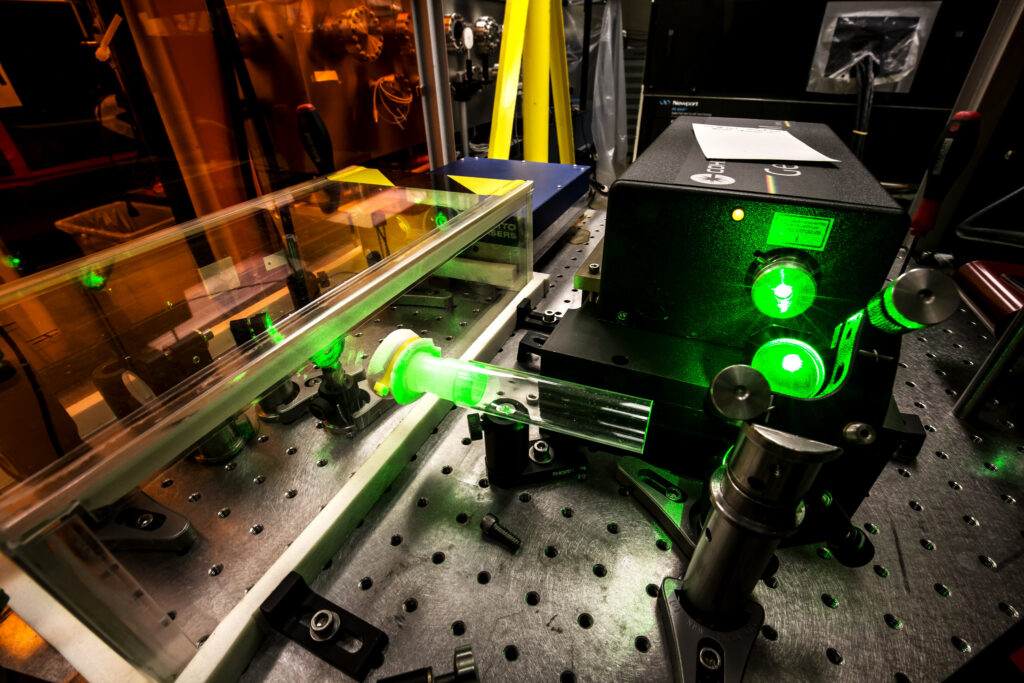Resources
Resources
$6.8M initiative to enable American laser renaissance
Oct 30, 2018. News

The HERCULES laser holds the Guinness World Records certificate for highest intensity focused laser, producing a beam of 2×10^22 W/cm^2. Photo: Joseph Xu
Source: The Michigan Engineer News Center
Written by: Kate McAlpine
In an effort to improve American competitiveness in high intensity laser research, the Department of Energy has established LaserNetUS, a $6.8 million initiative that involves the University of Michigan—one of the field’s pioneers.
High-intensity lasers have a broad range of applications in basic research, manufacturing and medicine. The new network, comprised of six universities and three national laboratories that operate high-intensity lasers, includes some that can exceed a petawatt, or a million billion watts.
Petawatt lasers generate light with nearly 100 times the output of all the world’s power plants—but only in the briefest of bursts. Using the technology pioneered by two of the winners of this year’s Nobel Prize in Physics, called chirped pulse amplification, these lasers fire off ultrafast bursts of light shorter than a tenth of a trillionth of a second.
U-M will receive $1 million through the initiative for providing time on the HERCULES laser, the reigning world champion for laser intensity at 20 sextillion (2×1022) watts per centimeter squared. HERCULES is currently undergoing a power upgrade from 300 trillion watts to 500 trillion or a petawatt. That should double or triple its intensity as well.
“While experiments with HERCULES have made many discoveries over the past decade, the facility doesn’t run as much as it could. LaserNet will help expand this growing research field by enabling access to HERCULES for scientists from outside the University of Michigan,” said Karl Krushelnick, the director of the Center for Ultrafast Optical Science (CUOS).
One of the newest Nobel laureates is CUOS founder Gérard Mourou, the A. D. Moore Distinguished University Professor Emeritus of Electrical Engineering and Computer Science at U-M. He proposed HERCULES to the National Science Foundation in 2000 and initiated the laser’s construction.
High-intensity lasers like HERCULES and the others in the network have a broad range of applications in basic research, manufacturing and medicine. For example, they can recreate some of the most extreme conditions in the universe, such as those found in supernova explosions and near black holes. They can generate high-energy particles for physics research or intense X-ray pulses to probe ultrafast processes, such as those occurring inside atoms. They are also promising for generating intense neutron bursts that could image aging aircraft components, cut materials precisely or deliver tightly focused radiation therapy to cancer tumors.
The U.S. was the dominant innovator and user of high-intensity laser technology in the 1990s, but now Europe and Asia have taken the lead, according to a recent report from the National Academies of Sciences, Engineering and Medicine titled “Opportunities in Intense Ultrafast Lasers: Reaching for the Brightest Light.” Currently, 80 to 90 percent of the world’s high-intensity ultrafast laser systems are overseas, and all of the highest power research lasers currently in construction or already built are also overseas. The report’s authors recommended establishing a national network of laser facilities to emulate successful efforts in Europe.
LaserNetUS was established for exactly that purpose. The network will hold a nationwide call for proposals for access to its facilities, and the proposals will be peer reviewed by an independent panel. This call will allow any researcher in the U.S. to get time on one of the high intensity lasers at the LaserNetUS host institutions.
The LaserNetUS institutions are the University of Texas at Austin, the Ohio State University, Colorado State University, the University of Michigan, the University of Nebraska-Lincoln, University of Rochester, SLAC National Accelerator Laboratory, Lawrence Berkeley National Laboratory and Lawrence Livermore National Laboratory. The funding comes from the DOE’s Fusion Energy Sciences program (FES) within the Office of Science.
The National Science Foundation is funding the HERCULES upgrade. Krushelnick is also a professor of nuclear engineering and radiological sciences, electrical engineering and computer science, and physics.
More From News